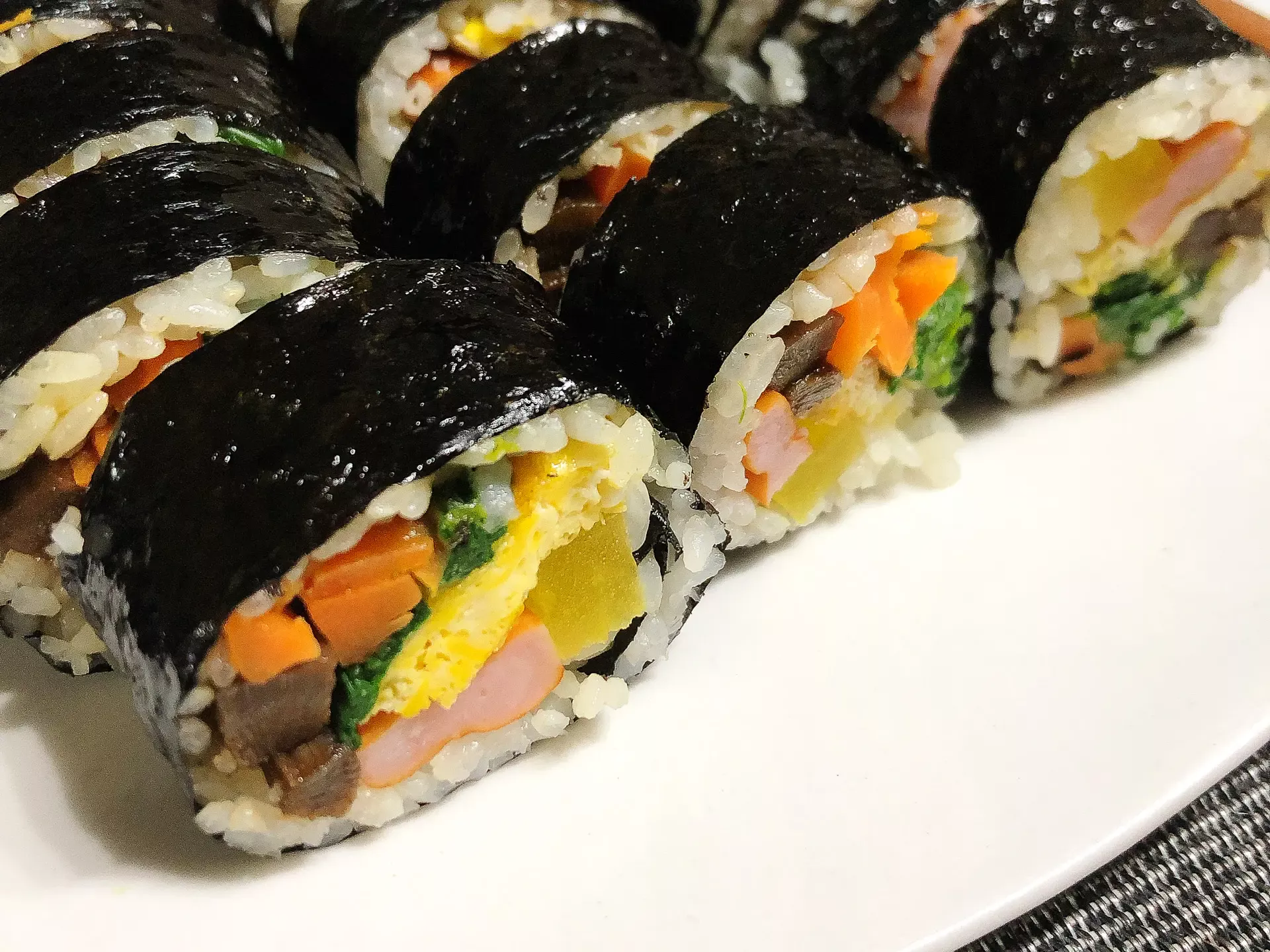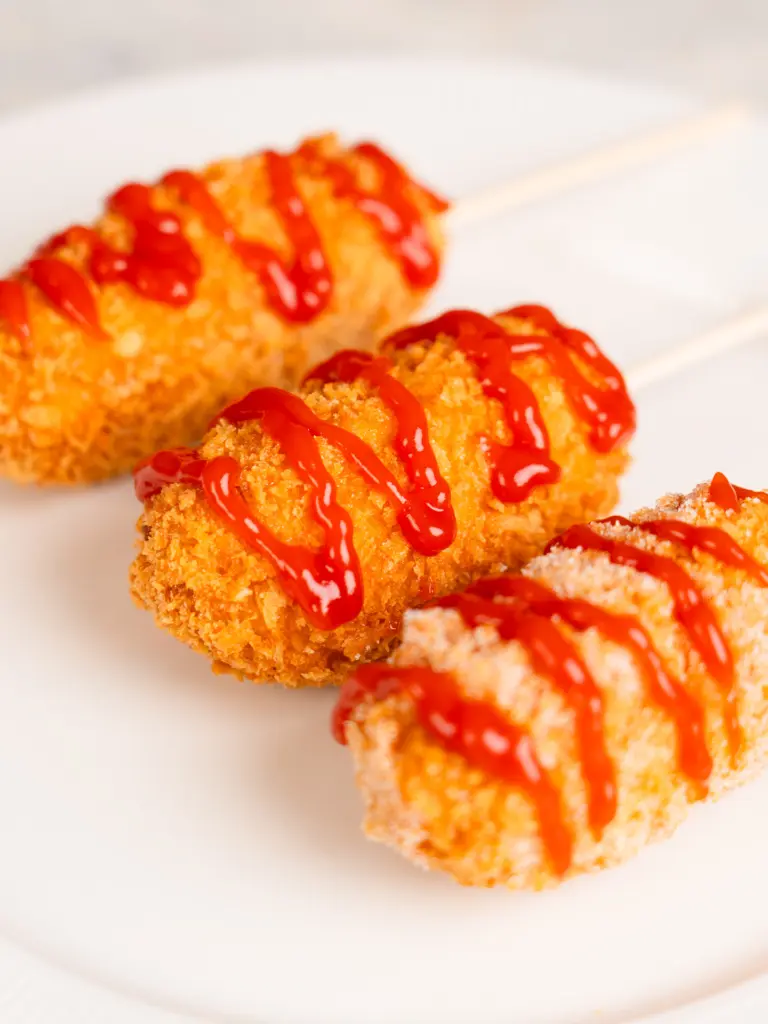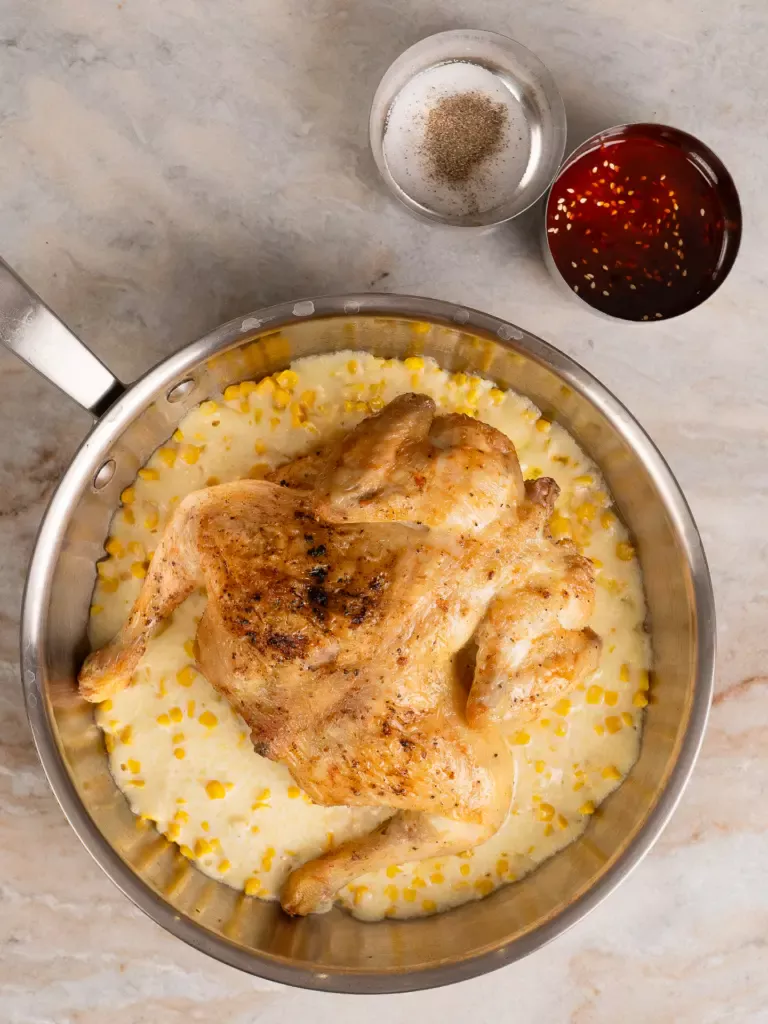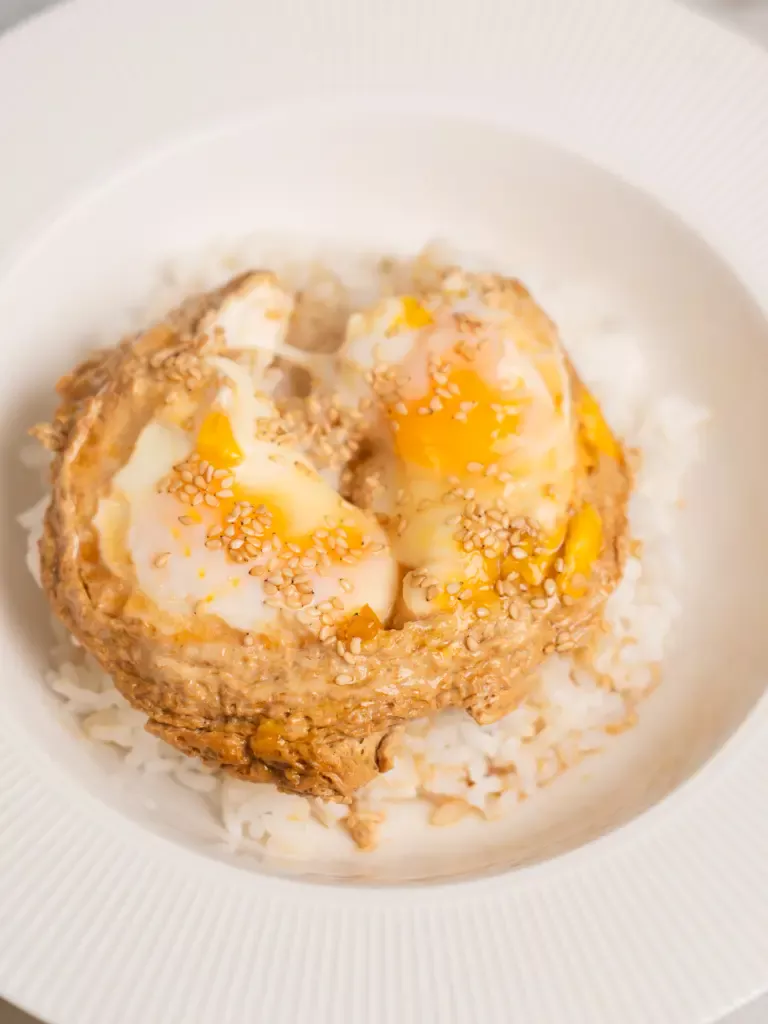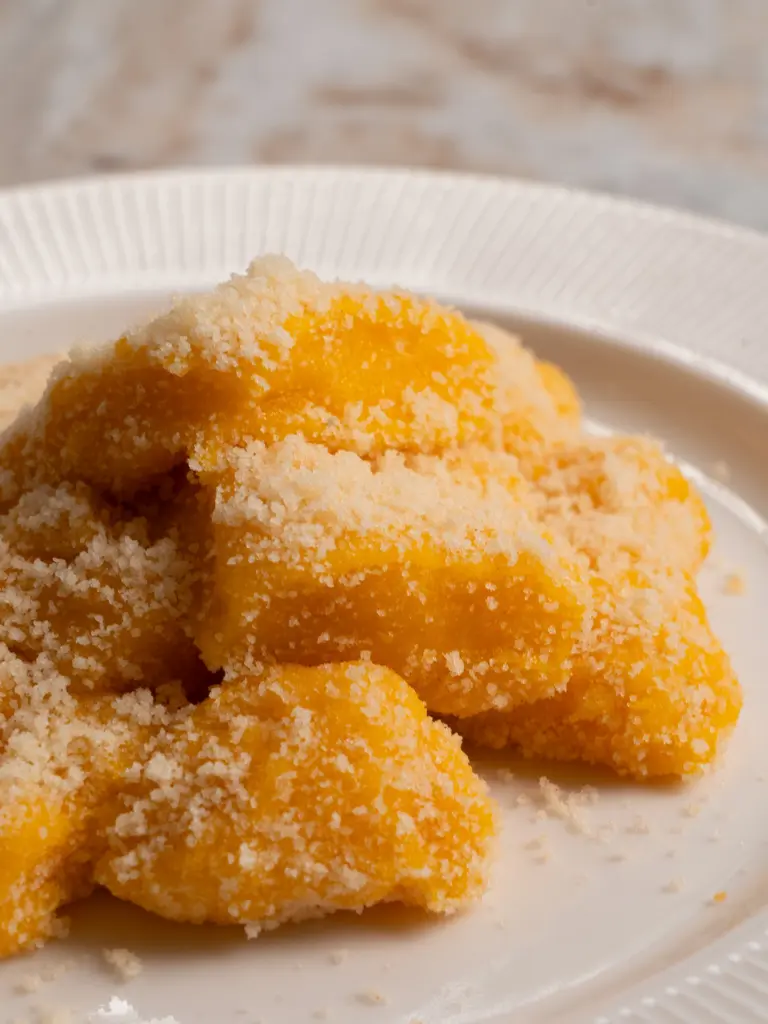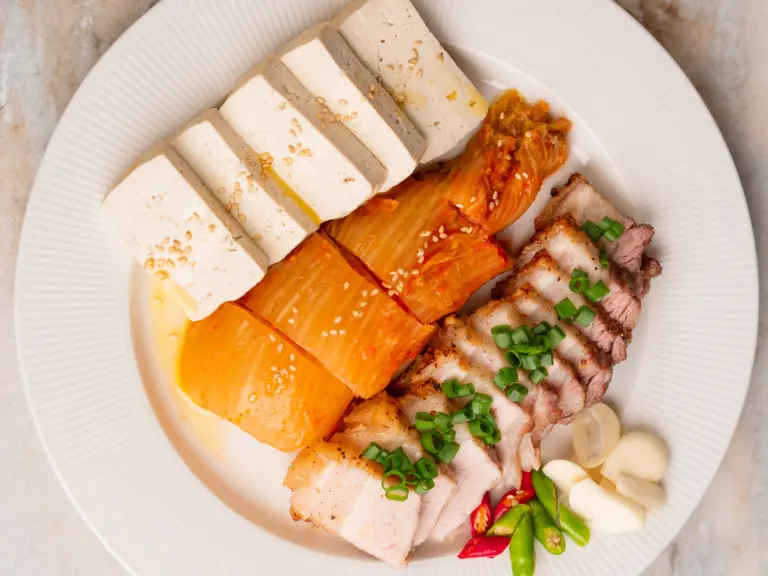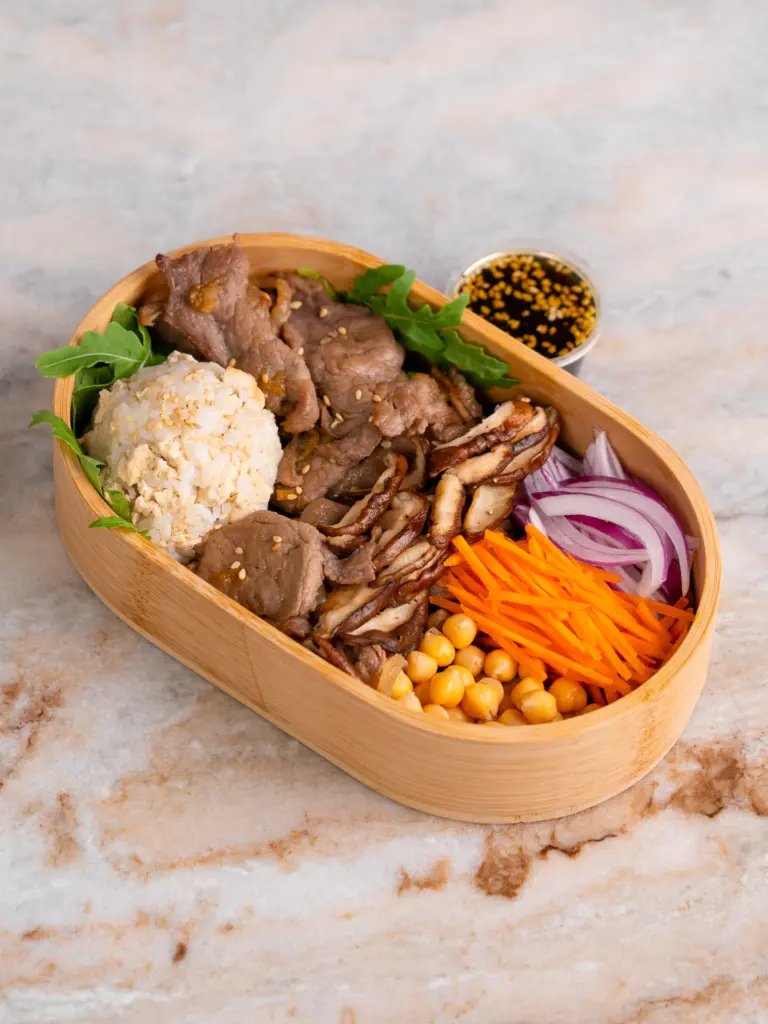10 Korean Kimbap Varieties (Stop Calling It Korean Sushi!)
Even K-pop Demon Hunters’ Rumi loves gimbap! As a Korean local, I’m sharing 10 of the best kimbap menus you must try. If you ever visit Korea, pick from this list and enjoy a variety of delicious gimbap! And don’t worry! I’ll also share the ingredients and kimbap recipes so you can make them at home, even if you’re not in Korea!
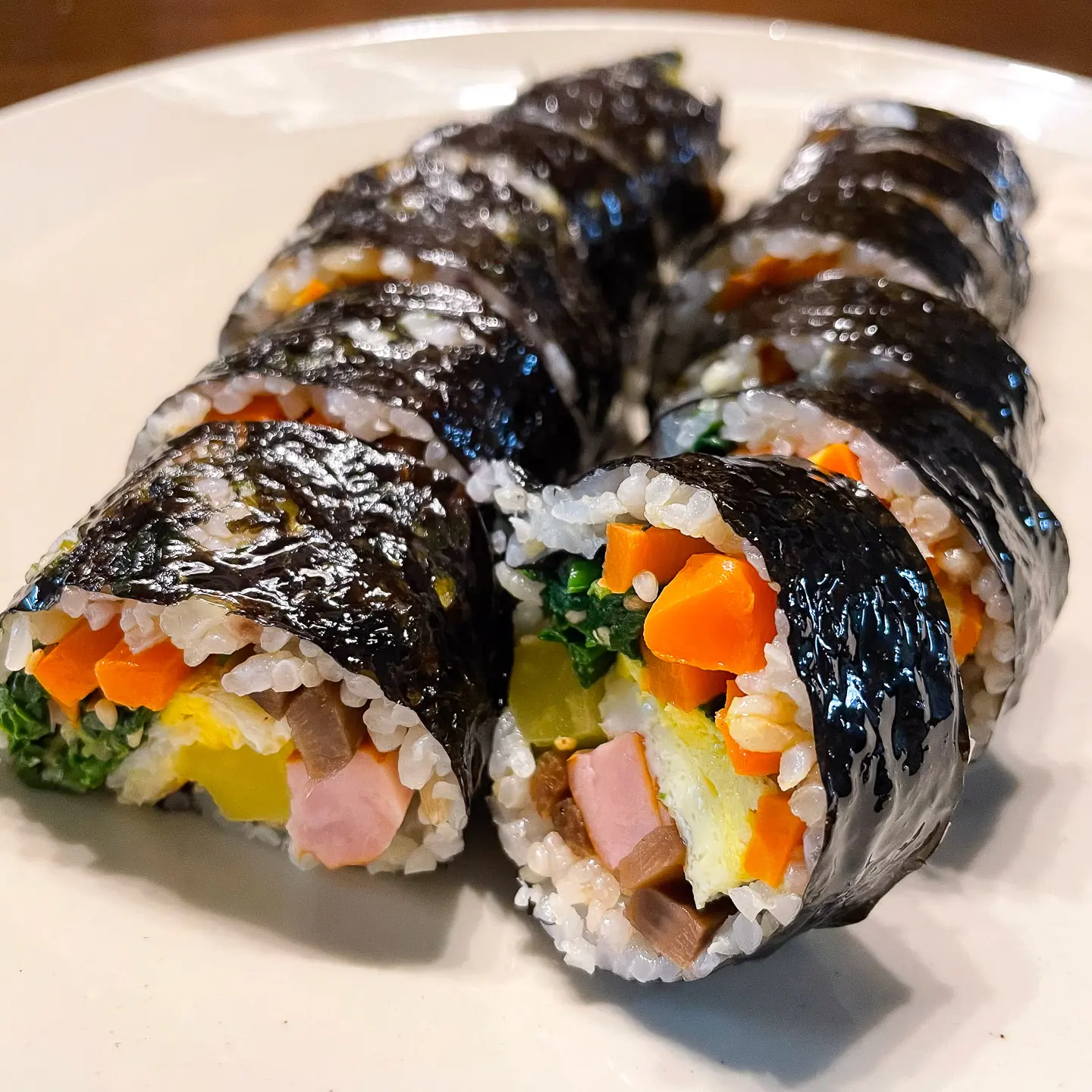
What is Kimbap? 김밥
Gimbap is a Korean seaweed roll made by seasoning rice with salt and sesame oil, topping it with various kimbap fillings such as vegetables and ham, and rolling it up in dried seaweed. Depending on the fillings used, there are thousands of possible variations of the kimbap.
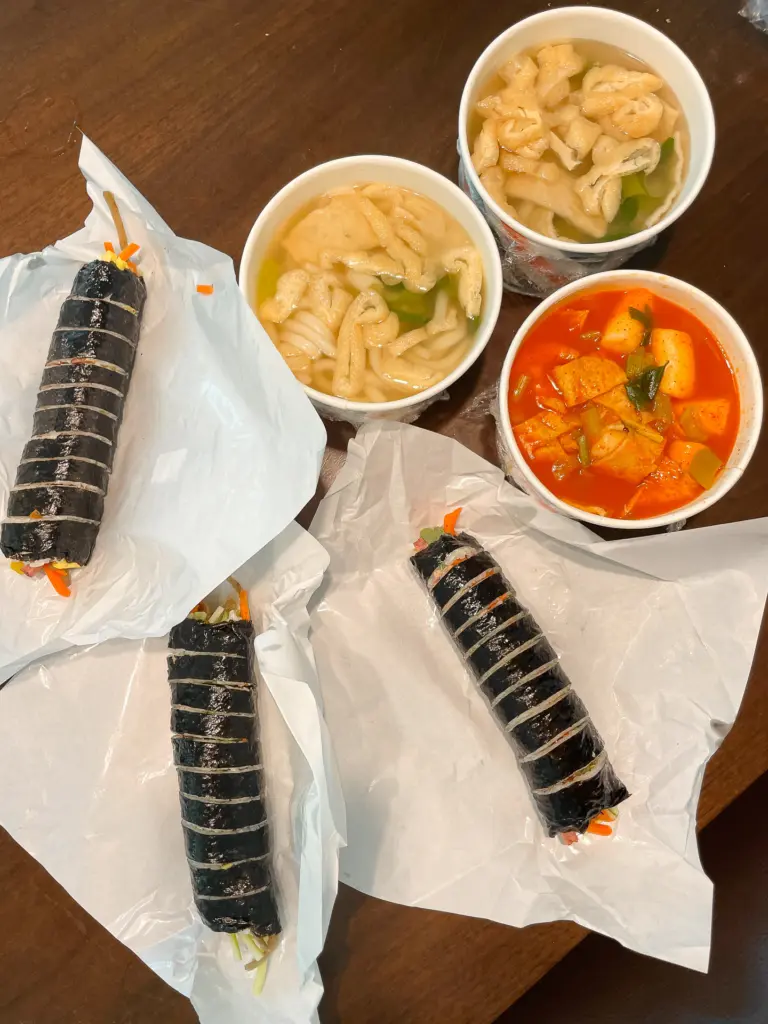
It’s a well-balanced food that contains carbohydrates, protein, and fat. In the past, many people would buy gimbap in the morning to eat at work, but these days it’s more commonly enjoyed as a quick lunch. Gimbap is also one of the most popular picnic lunchbox items in Korea.
Kimbap Is Not Korean Sushi
Gimbap is not sushi. Recently, I’ve seen people calling gimbap “Korean sushi,” and I wanted to point out how different they actually are. From the way the rice is seasoned, to the type of seaweed used, to the fillings inside—everything is different between Korean kimbap and Japanese sushi. In this blog post, I’ve explained in detail how they differ, from the ingredients to the taste.
Korean Bunsik 분식
Gimbap is one of many dishes in the bunsik category in Korean cuisine. The term bunsik literally means “food made from flour” and originally referred to dishes made with wheat flour. Although kimbap is not made from flour, it is classified as a bunsik dish.
Bunsik culture began in the 1960s and 1970s due to government policies aimed at reducing rice consumption and increasing wheat consumption. Popular bunsik dishes include tteokbokki (spicy rice cakes), corn dogs, ramyeon, sundae (Korean blood sausage), and eomuk (fish cakes). These foods were commonly sold at small bunsik shops near schools and were often considered a type of Korean “school food.”
Easiest Korean Cheese Corn Dog (치즈 핫도그)
Today, with the rise of chain restaurants, many traditional school-front bunsik shops have disappeared. Koreans usually think of bunsik as a quick, affordable meal—something to grab during a busy lunch break or enjoy with friends after school.
10 Best Korean Kimbap Menu
I’ll share 10 must-try gimbap varieties. I’ve also included the ingredients and recipe for kimbap so you can make them at home—even if you’re not in Korea—so be sure to give them a try!
Basic Kimbap
- Ingredients: Rice seasoned with salt and sesame oil, seaweed for gimbap, pickled radish (danmuji), carrot, egg, crab stick (imitation crab), spinach, ham, burdock root, fish cake, cucumber, and more.
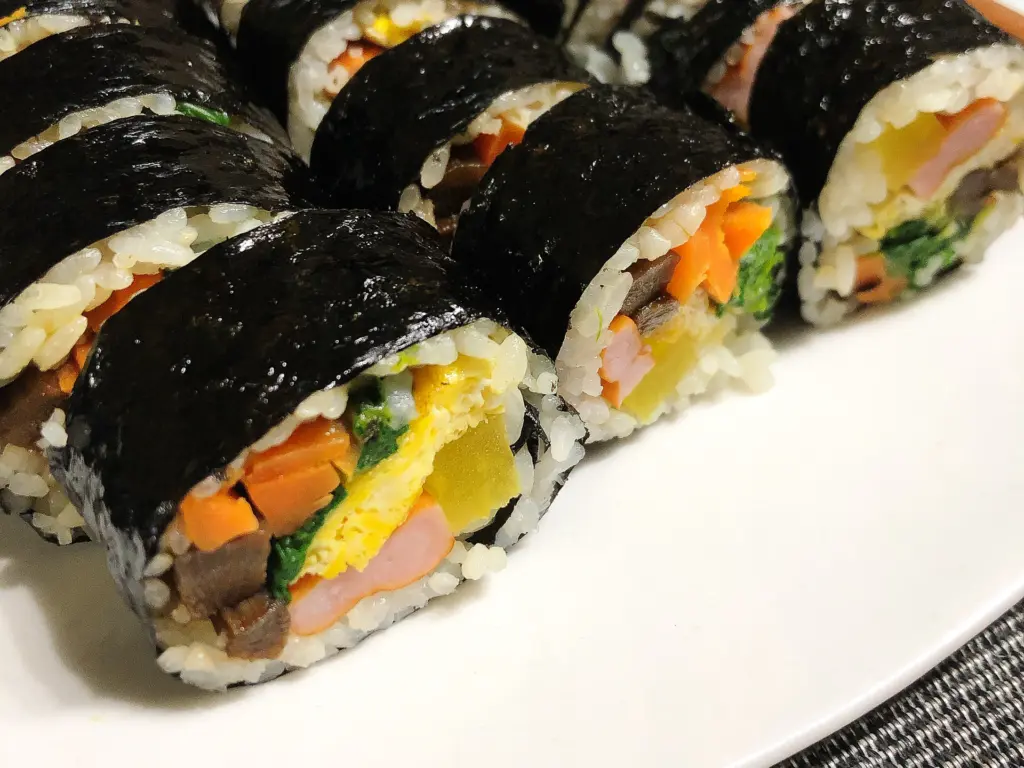
The essential fillings for basic gimbap are pickled radish, ham, egg, carrot, crab stick, and spinach. Other optional ingredients include fish cake, burdock root, and cucumber, which are based on personal preference.
This classic gimbap recipe features savory, sesame oil–flavored rice combined with crunchy carrots and pickled radishes, rich ham and eggs, and lightly seasoned spinach, creating a delicious, well-balanced roll.
Tuna Kimbap
- Ingredients: Rice seasoned with salt and sesame oil, seaweed for gimbap, canned tuna, mayonnaise, perilla leaves (kkaennip), egg, ham, pickled radish (danmuji), carrot, cucumber, burdock root, fish cake, and more.
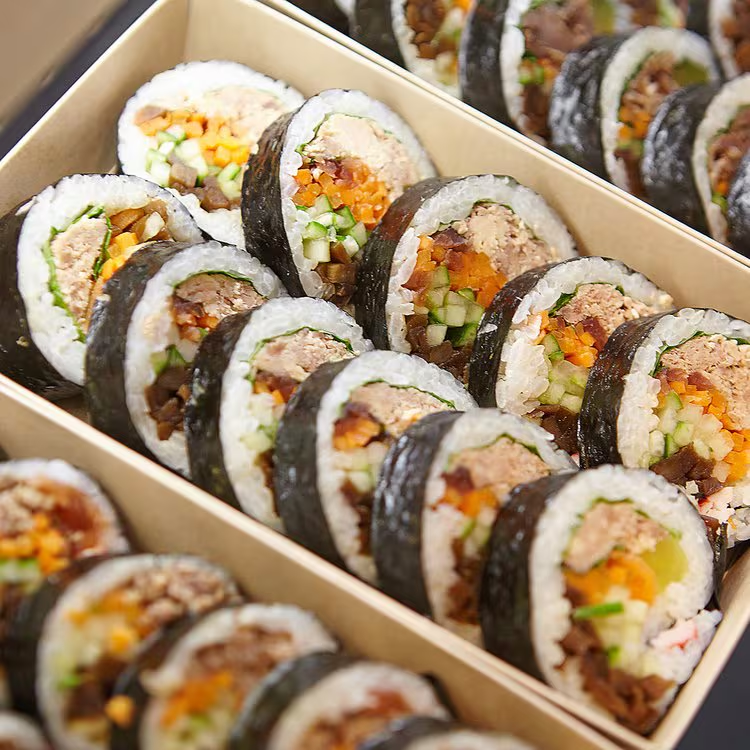
This gimbap’s main feature is its tuna mayo mixture, complemented by aromatic perilla leaves that give it a unique, refreshing flavor. Essential ingredients include tuna mayo, perilla leaves, egg, pickled radish, and carrot. You can add other ingredients according to your preference to create different styles. Many Koreans prefer tuna mayo gimbap to the basic version.
Sinjeon Cheese Kimbap
- Ingredients: Kimchi fried rice, canned tuna, mozzarella cheese, seaweed for gimbap.
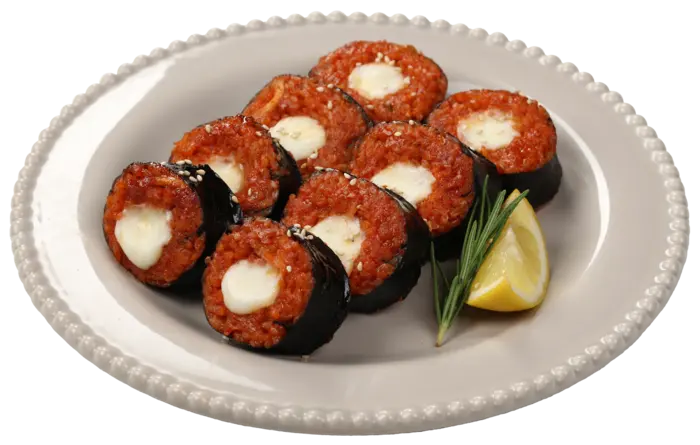
This is a popular menu item from Sinjeon Tteokbokki, a well-known Korean street food restaurant. Many Koreans order it with their tteokbokki. The kimchi fried rice is made spicy by mixing in tuna and spreading it over seaweed. Melted mozzarella cheese is generously layered on top before rolling, creating a spicy cheese gimbap.
The combination of spicy flavors and creamy cheese is delicious, and it’s even better when dipped in tteokbokki sauce. You don’t have to be in Korea to enjoy it—you can easily make it at home!
Cheese Kimbap
- Ingredients: Rice seasoned with salt and sesame oil, seaweed for gimbap, sliced cheddar cheese, pickled radish (danmuji), carrot, egg, fish cake, crab stick, spinach, ham, burdock root, cucumber, and more.
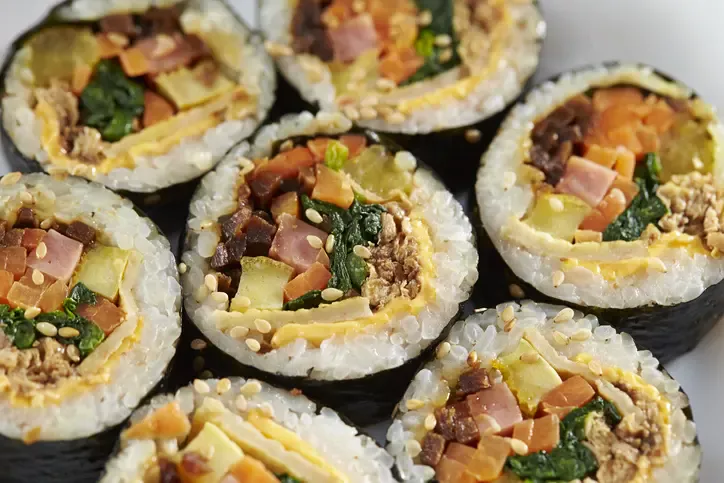
This gimbap is made by simply adding sliced cheddar cheese to the basic gimbap ingredients. It’s one of the favorites among kids for its mild and creamy flavor.
Samgyeopsal Kimbap
- Ingredients: Rice seasoned with salt and sesame oil, seaweed for gimbap, Korean BBQ grilled pork belly (samgyeopsal), lettuce, perilla leaves (kkaennip), chili peppers, pickled radish wrap (ssammu), and ssamjang (Korean dipping sauce).
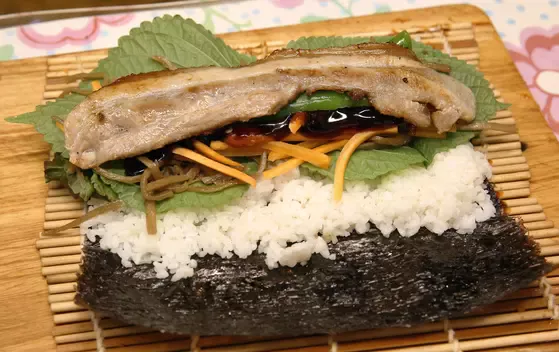
Imagine taking all the delicious ingredients from Korean barbecue wraps and putting them into one roll. Spread rice on the seaweed and layer it with fresh lettuce, perilla leaves, pickled radish, perfectly grilled thick pork belly, chili peppers, and savory ssamjang. This gimbap has the amazing BBQ flavor you love—it’s impossible for it not to taste delicious!
Bulgogi Kimbap
- Ingredients: Rice seasoned with salt and sesame oil, seaweed for gimbap, thinly sliced beef marinated in bulgogi sauce (soy sauce, sugar, garlic, sesame oil, etc.), egg, carrot, pickled radish (danmuji), crab stick, spinach, lettuce or perilla leaves, cucumber, burdock root, and more.
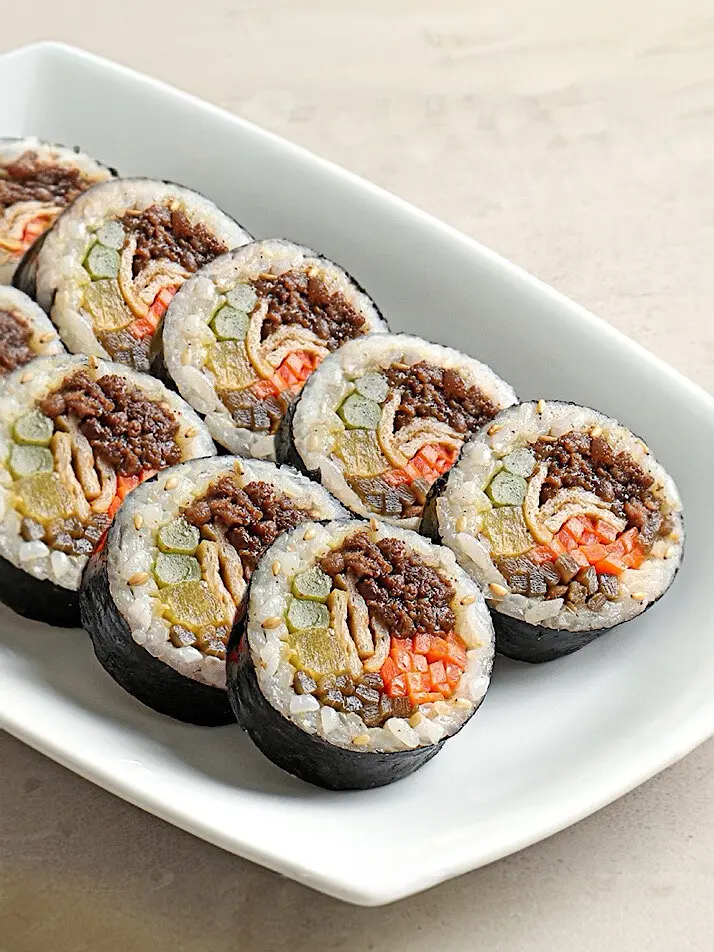
The sweet and savory bulgogi beef is the main of this gimbap. Egg, carrot, and pickled radish are essential fillings, while other ingredients can be added based on your preference. For extra crunch and freshness, I recommend adding cucumber or leafy greens like lettuce.
Donkatsu Gimbap
- Ingredients: Rice seasoned with salt and sesame oil, seaweed for gimbap, fried pork cutlet (donkatsu), egg, carrot, pickled radish (danmuji), burdock root, cucumber, lettuce, spinach, and more.
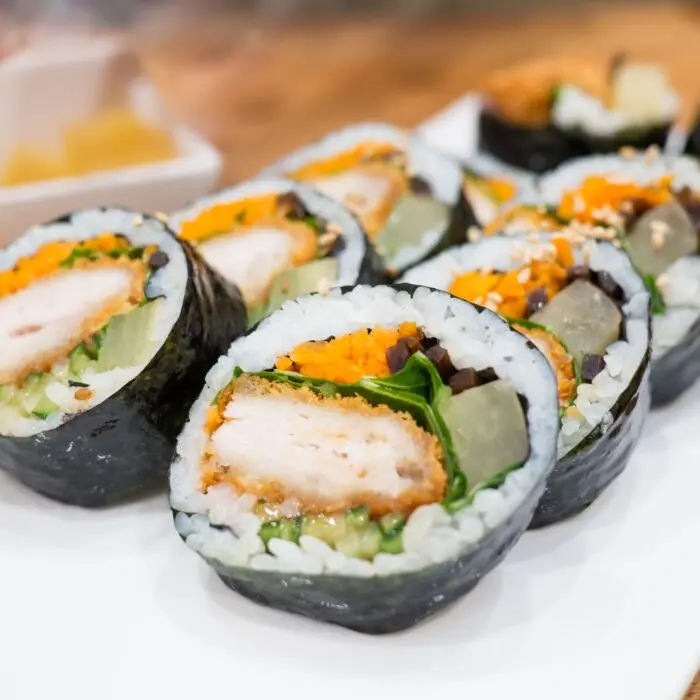
The main ingredient is a crispy fried pork cutlet coated with panko breadcrumbs. Egg, carrot, and pickled radish are included as standard fillings, while the other ingredients can be added based on your preference. This gimbap is a hearty meal, and it’s especially delicious when dipped in donkatsu sauce. Kids especially love this one!
Kkoma Gimbap
- Ingredients: Rice seasoned with salt and sesame oil, seaweed for gimbap, pickled radish (danmuji), carrot, egg, spinach, ham, cucumber, and more.
Kkoma gimbap means “mini gimbap.” It is made by cutting the seaweed into smaller pieces and rolling smaller portions than regular gimbap. It usually contains fewer fillings and less rice. Essential fillings include carrot, pickled radish, and egg, though other ingredients can be added based on preference.
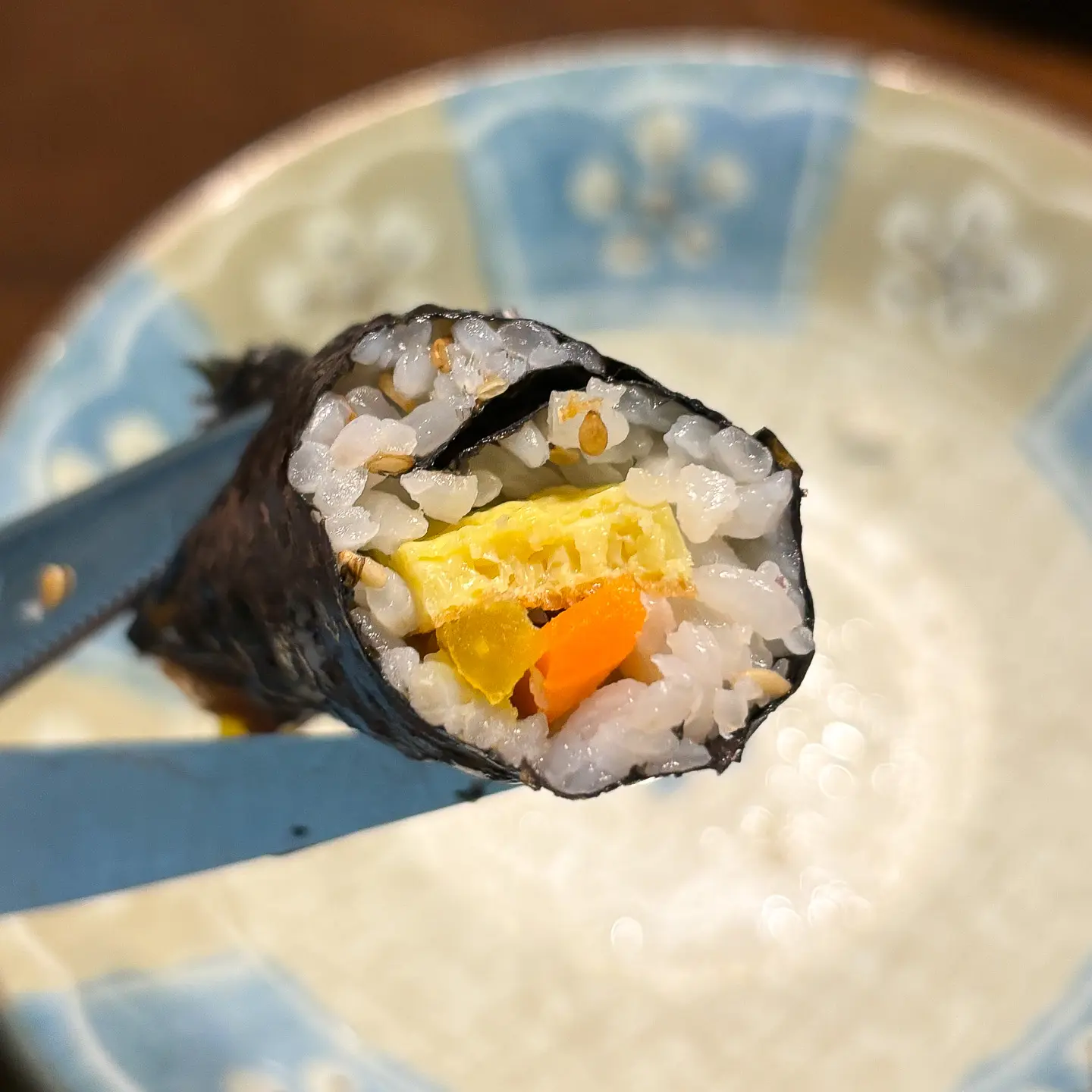
If you’ve been to Gwangjang Market, you might have seen “mayak kimbap,” a type of mini gimbap served with a special mustard-soy dipping sauce. Koreans call this “addictive gimbap” because mayak means “drug” in Korean!
Keto Kimbap
- Ingredients: Seaweed for gimbap, egg sheet, carrot, ham, pickled radish (danmuji), spinach, cucumber, etc.
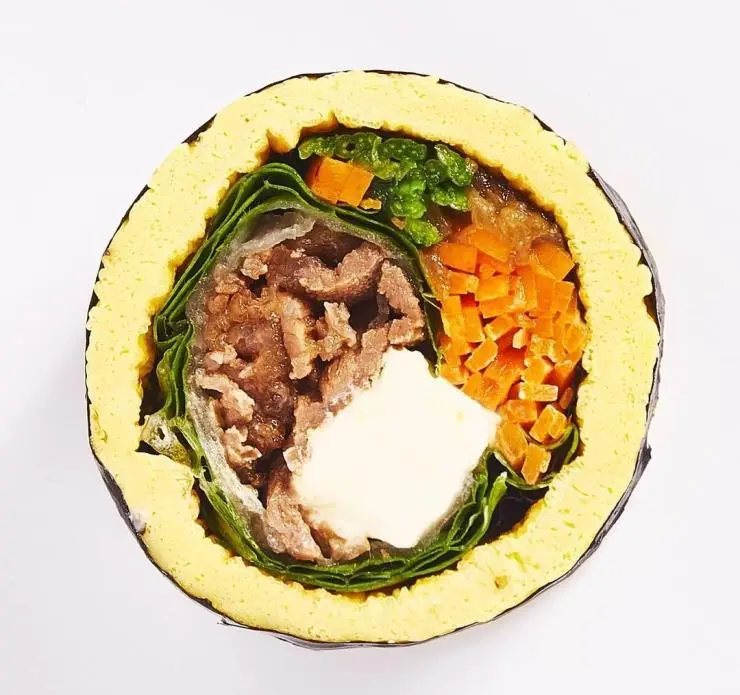
This gimbap was created in Korea during the low-carb, high-fat (ketogenic) diet trend and contains no rice. It is sought after by people who want to reduce carbohydrates and lose weight. Instead of rice, it is filled with eggs to provide fullness and protein, making it a popular diet meal. There are even restaurants that sell only this keto gimbap. If you want to lose weight, I recommend you try making it. It makes you feel light and is really delicious.
Chungmu Kimbap
- Ingredients: Rice seasoned with salt and sesame oil, seaweed for gimbap, spicy marinated squid, radish kimchi
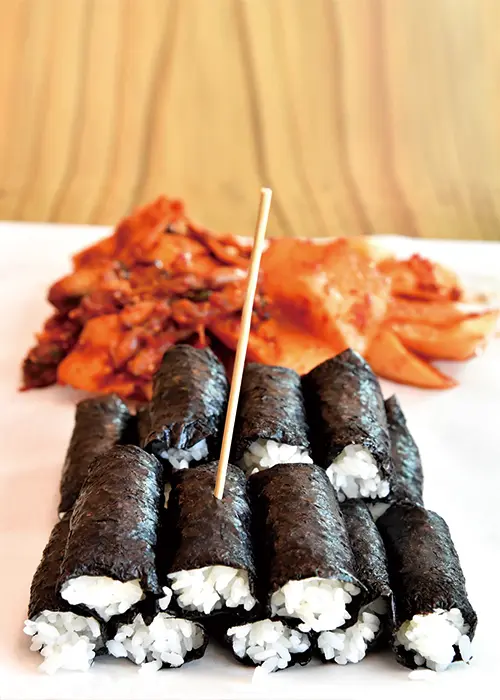
This gimbap originates from Chungmu in the Gyeongsangnam-do region. Its unique feature is that the seaweed is rolled with only rice, with no other fillings inside. Traditionally, it is eaten with two side dishes: spicy marinated squid and radish kimchi. The combination of these spicy sides with the plain gimbap makes for a delicious meal. It’s one of my favorites, but it’s been hard to find squid since moving to Europe, so I miss being able to eat it. If you visit Korea, I highly recommend trying it!

